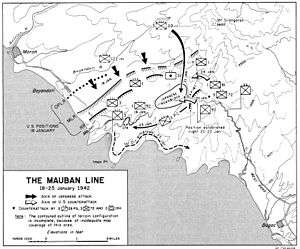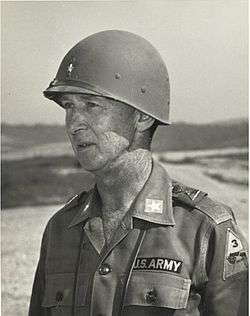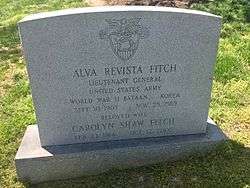Alva R. Fitch
| Alva R. Fitch | |
|---|---|
|
Alva Revista Fitch in 1966 | |
| Born |
September 10, 1907 Amherst, Nebraska |
| Died |
November 25, 1989 (aged 82) Washington, D.C. |
| Place of burial | Arlington National Cemetery |
| Allegiance | United States of America |
| Service/ | United States Army |
| Years of service | 34 years |
| Rank | Lieutenant General |
| Commands held | 3rd Armored Division |
| Battles/wars |
Battle of Bataan Korean War |
| Awards |
Distinguished Service Cross Distinguished Service Medal Legion of Merit Silver Star Bronze Star |
Alva Revista Fitch (September 10, 1907 – November 25, 1989) was a lieutenant general in the United States Army and was deputy director of Defense Intelligence Agency from 1964 to 1966.[1] He commanded an artillery battalion during the Battle of Bataan and was a prisoner of war from 1942 to 1945. From October 16, 1961 to January 5, 1964, Fitch served as the Assistant Chief of Staff for Intelligence, Headquarters, Department of the Army.[2]
Early life
Born in Amherst, Nebraska on September 10, 1907, son of Gertrude De La Barre and John Albert Fitch.[3] Fitch was the first Eagle Scout in Nebraska, and one of the very earliest west of the Mississippi River. He graduated from Kearney High School and received an appointment to West Point, having been nominated by Nebraska senator Robert B. Howell.
Junior officer
Fitch graduated from the United States Military Academy at West Point in June 1930 and became a second lieutenant in the Field Artillery.[4] He was promoted to first lieutenant in September 1935 and served as Aide de Camp to Get. Leslie J. McNair from 1937 to 1939.[5]
World War II

Fitch was sent to Fort Stotsenburg in the Philippines in February 1940 and He commanded Battery A of the 23rd Field Artillery Regiment, which was armed with horse and mule drawn QF 2.95-inch Mountain Guns.[6] He was promoted to captain in June 1940.
After the invasion of the Philippines began on 8 December 1941, the 23rd Field Artillery was attached to the 26th Cavalry Regiment on December 13[6] and retreated with other units of I Corps to Bataan.[7] Fitch was promoted to major in January 1942 and was put in command of the 71st Field Artillery when Colonel Halstead C. Fowler was wounded. Fitch received the Distinguished Service Cross for leading a battalion of artillery cut off by Japanese encirclement to remaining I Corp units south of Mauban.[8][9] He was captured in May 1942 a few days after surrender and taken prisoner.
A survivor of the Bataan Death March, he was held at Luzon at Camp O'Donnell[10][11] In December 1944 he was transferred with other Bataan survivors aboard the Ōryoku Maru to the Fukuoka prison camps.[12] He was released in September 1945. He was awarded the Distinguished Service Cross and the Silver Star for heroism and courage in combat and while a captive of the Japanese.[13]
Post-war

From February to July 1946 he attended the Command and General Staff College at Fort Leavenworth, Kansas and remained as an instructor until August 1947.[4]
In the Korean War, Fitch was an artillery commander and then commanded the 3rd Armored Division. He later served as Chief of Staff of Army Intelligence before being named to the Defense Intelligence Agency post in 1964.
Military intelligence
He served on the Army Aircraft Requirements Review Board, also known as the Rogers Board, which was established on January 15, 1960 by the Army Chief of Staff to review the Army Aircraft Development Plan and the related industry proposals. The Rogers Board's members included Major Generals Hamilton H. Howze, Thomas F. Van Natta, Robert J. Wood, Richard D. Meyer, Ernest F. Easterbrook, and chairman Lieutenant General Gordon B. Rogers; and its results prefigured the more influential Howze Board on airmobility.[14]
Retirement and death

Fitch retired from active duty in 1966 and was military editor of the Kiplinger Newsletter from 1966 to 1975.
He died at Walter Reed Army Medical Center, Washington, D.C., on November 25, 1989 and was buried in Section 30 of Arlington National Cemetery.[3] General Fitch is a member of the Military Intelligence Hall of Fame.
Notable subordinates
General Fitch was Elvis Presley's commanding officer during the singer's stint in the Army from 1958 to 1960.
Future U.S. Secretary of State Colin Powell was a lieutenant with the 3rd Armored Division under General Fitch.
See also
Notes
- ↑ May, Eric Charles (1989-11-28). "Lt. Gen. Alva R. Fitch Dies". The Washington Post. Retrieved 2016-10-12.
- ↑ "Faces of Defense Intelligence: Lt. Gen. Alva R. Fitch". DIA News. Washington, D.C.: Defense Intelligence Agency. 2016-06-13. Retrieved 2016-10-12.
- 1 2 "Memorial for LTG Alva R. Fitch". Cullum No. 8879. Arlington, VA: Arlington National Cemetery. 1989-11-25. Retrieved 2016-10-12.
- 1 2 "Briefing of Major General Alva R. Fitch". CIA FOIA Electronic Reading Room. Central Intelligence Agency. 1959-10-01. Retrieved 2016-11-01.
- ↑ "Convention Speaker Lieutenant General Alva Revista Fitch" (PDF). The Quan. 20 (5): 1. April 1966. Retrieved 2017-04-21.
- 1 2 Raymond G. Woolfe Jr. (26 May 2016). The Doomed Horse Soldiers of Bataan: The Incredible Stand of the 26th Cavalry. Rowman & Littlefield Publishers. ISBN 978-1-4422-4535-8.
- ↑ Stevens, Peter (1 April 2011). Twilight Riders: The Last Charge of the 26th Cavalry. Lyons Press. pp. 283–. ISBN 978-0-7627-6939-1.
- ↑ "Alva Restiva Fitch". Hall of Valor Database. Military Times. Retrieved 2017-04-20.
- ↑ The Times When Men Must Die: The Story of the Destruction of the Philippine Army During the Early Months of World War II in the Pacific, December 1941-May 1942. Dorrance Publishing. pp. 66–67. ISBN 978-1-4349-5563-0.
- ↑ Gregory J. W. Urwin (15 November 2010). Victory in Defeat: The Wake Island Defenders in Captivity, 1941-1945. Naval Institute Press. pp. 440–. ISBN 978-1-59114-899-9. Retrieved 1 January 2013.
- ↑ Kenneth B. Murphy; James T. Murphy (15 May 2009). When Men Must Live: An Inspirational True Story of Courage, Hope, and Freedom. BookBaby. ISBN 978-0-9823258-1-0.
- ↑ "American Affidavits". Prisoner of War Camp #1 Fukuoka, Japan. Retrieved 2017-04-20.
- ↑ Alexander, Irvin (10 July 2005). Surviving Bataan And Beyond: Colonel Irvin Alexander's Odyssey As A Japanese Prisoner Of War. Stackpole Books. pp. 266–. ISBN 978-0-8117-3248-2. Retrieved 1 January 2013.
- ↑ "Chapter 1 The Growth of the Airmobile Concept". Airmobility 1961-1971. Vietnam Studies. United States Army Center of Military History. 1989. CMH Pub=1989.
References
- Black, J. K. United States Penetration of Brazil. 1977 (page 183, 188)
- Fitch, A. R. Autobiography of Alva Revista Fitch, Fitch family genealogy collection, unpublished, 1984, page 4
- Mader, Julius Who's Who in CIA. 1968
- Newman, John M. JFK and Vietnam: Deception, Intrigue, and the Struggle for Power. 1992 (page 33, 186)
- Powers, T. The Man Who Kept the Secrets. 1981 (page 271)
External links
| Wikimedia Commons has media related to Alva R. Fitch. |